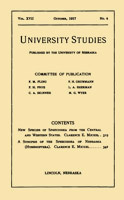University Studies of the University of Nebraska
Date of this Version
9-1968
Citation
University of Nebraska Studies: New Series no. 37
Abstract
The economic growth of states and regions in the American economy follows divergent patterns. During the period from 1910 to 1950, for example, the labor force in Nebraska grew at a slower rate than did the national labor force. Nebraska had over onequarter of a million fewer workers than would have been the case if growth in Nebraska had occurred at the national rate. More recently it has been observed that employment in Nebraska increased 25 percent from 1939 to 1958. This increase does not compare favorably with the nation as an employment "growth gap" (the difference in state and national growth) of 62,331 persons occurred over this time period. In this same period of time Nebraska's relative commitment to agriculture increased with the nation. In 1939, 46.1 percent of total employment originated in the agricultural sector in Nebraska, a ratio 1.7 times as great as the national average.l Agricultural employment in 1958 was 30.7 percent of total employment in Nebraska, as absolute specialization in agriculture declined in Nebraska. This compares with a national average of 12.9 percent of employment in agriculture. Thus, Nebraska's reliance on this sector was 2.3 times as great as the nation's in 1958. This is important because agricultural specialization does bear heavily upon the growth problems of this state.
The current position of the Nebraska economy reflects historical patterns initiated by the early development of agricultural and related primary resources. This furnished a development base for the appearance of ancillary economic activities-activities which tend to number among those that currently are declining or static in relative importance. In short, the current "satellite" industry structure has not provided adequate job opportunities for residents of the state. The fact that these growth trends critically affect the wellbeing of area residents is apparent to all. Nebraska, for example, has experienced difficulty in maintaining perhaps the most vital growth ingredient of all-human resources. Employment opportunities have been provided for some of the area's released agricultural population, and economic growth has been more rapid in some sectors than in others. At the same time, the growth base of the state (in terms of industry mix) is relatively small and the nature and extent of future area development is a substantial unknown. The future for the area is complicated by this uncertainty, by inadequate knowledge concerning past and present growth trends, and by a lack of assurance that leaders of the region have concerning their ability to cope with the complex and nearly endless variety of situations which a dynamic national economy promises to produce in the years ahead.
The impetus for this study is furnished by (1) a widespread area concern for the present and future growth potential of the state and (2) concern for the development and utilization of human resources presently residing in the state. Although the Nebraska economy cannot be described fairly as depressed, a detailed awareness of the nature of the state economy and of the existence and location of unused potential is necessary to attain optimum future exploitation of this growth potential. Policy implementation is also necessary, but effective policy requires analysis first. An understanding of the magnitude, the incidence, and the direction of sluggish growth rates and undesirable population, income, and employment patterns within the state economy is a requisite to the application of policies designed to promote economic viability.


Comments
Published by The University at Lincoln